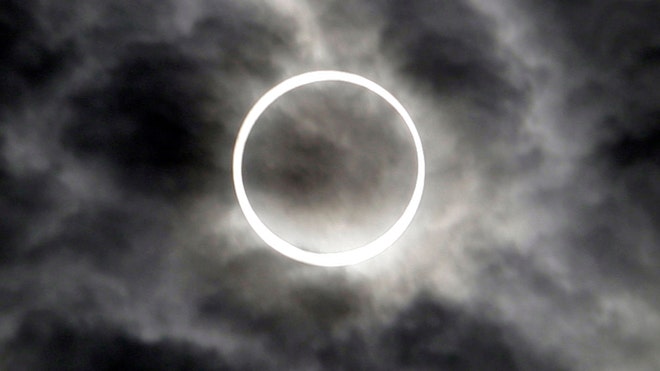Solar Eclipse: Millions Look Up for 'Ring of Fire'
Published May 20, 2012
Fox News Latino

TOKYO – For one night, millions of eyes look up to the 'Ring of Fire.'
Millions around the world are set to watch the annular solar eclipse, in which the moon passes in front of the sun leaving only a golden ring around its edges, which will be visible to wide areas across Asia Monday morning, parts of the western United States and even some parts of Mexico will catch a glimpse.
Parts of eastern Asia were being treated to a solar spectacle as the moon slid across the sun, creating a
"ring of fire." Sky-watchers in the western U.S. awaited their turns as the rare phenomenon was due to move over the Pacific and toward them later Sunday.
Scientists cautioned would-be viewers everywhere to be very careful because the sun's damaging rays will remain powerful even during the annular solar eclipse. The advice: Either wear specially designed protective eyewear or attend a viewing event — at a planetarium or amateur astronomy club, for example — to avoid risk of serious eye injury.
Local weather permitting, the solar spectacle was first visible in parts of eastern Asia around dawn Monday, local time. If skies were clear enough, early risers there were able to catch the ring eclipse.
Later, the late day sun (on Sunday in the U.S.) will transform into a glowing ring in southwest Oregon, Northern California, central Nevada, southern Utah, northern Arizona and New Mexico and finally the Texas Panhandle.
For 3 ½ hours, the eclipse follows an 8,500-mile path with the ring-of-fire phenomenon lasting as long as 5 minutes, depending on location.
Outside this narrow band, other parts of the U.S. and portions of Canada and Mexico will be treated to a partial eclipse. The Eastern Seaboard will be shut out, but people can find online sites that plan to broadcast the event live.
It's impossible to know how many people plan to make an event of the ring-of-fire spectacle, the likes of which hasn't been seen in the continental U.S. for nearly two decades.
One clue to demand might be found at the planetarium at the University of Nevada, Reno, which had to order another 10,000 solar viewing glasses after it sold out of them — 17,000 pairs at $2 each — last week.
In Japan, "eclipse tours" were arranged at schools and parks, on pleasure boats and even private airplanes. Similar events were held in China and Taiwan as well.
Early risers in southern China, northern Taiwan and southeastern Japan will get the best view, weather permitting, around dawn Monday.
In Japan, cable cars will begin running early to give tourists an unobstructed view from the mountains, and ocean ferries will make special trips to allow viewing from offshore. Children will gather early at schools to view the eclipse with teachers. Stores are promoting special eclipse-viewing eyewear as well as ring-shaped goods of all sorts — from wedding rings to doughnuts.
In Tokyo, where a ring eclipse was last seen in 1839, the event dominated Sunday's TV talk shows, with hosts providing viewing tips and information about special activities.
In Taiwan, the Taipei Astronomical Museum will open its doors at dawn, while Hong Kong's Space Museum will set up solar-filtered telescopes outside its building on the Kowloon waterfront.
The eclipse will follow a narrow 13,700-kilometer (8,500-mile) path for 3 1/2 hours. The ring phenomenon will last about five minutes, depending on location. People outside the narrow band will see a partial eclipse.
An annular solar eclipse is not as dramatic as a total eclipse, when the disk of the sun is entirely blocked by the moon. As in a total solar eclipse, the moon crosses in front of the sun, but the moon is too far from Earth and appears too small in the sky to blot out the sun completely.
The rare astronomical event will give a 16.4 billion yen ($208 million) boost to Japan's economy from the sale of eyewear, tours, planetarium visits and other items, according to an estimate by Kansai University economist Katsuhiro Miyamoto.
A city-run zoo in Yokohama, near Tokyo, will open early to show visitors how animals may react. The zoo has also set up live cameras to capture the movement of elephants, monkeys, kangaroos and penguins. Yokohama is inside the narrow band where the ring eclipse will be visible, weather permitting.
"This is a chance that comes only once in hundreds of years. The data we collect will be extremely valuable for animal research," zoo official Yoshinori Kubo said.
In the western prefecture of Wakayama, another major viewing area, enthusiasts are organizing viewing parties at several locations.
Doctors and education officials warned of eye injuries from improper viewing. Education Minister Hirofumi Hirano demonstrated the use of eclipse glasses in a televised news conference.
Police also cautioned against traffic accidents caused by distraction during the eclipse and advised drivers to concentrate while on the road.
Japan's Meteorological Agency is predicting mostly cloudy weather in the country's eclipse viewing areas.
The last time this type of eclipse was seen in the U.S. was in 1994. This year's solar show offers ringside seats at 33 national parks along the eclipse path, including the Grand Canyon and Bryce Canyon. A partial eclipse can be viewed from another 125 national parks.
No comments:
Post a Comment